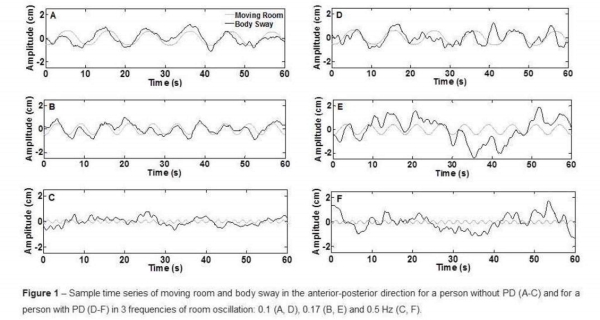Session Information
Date: Thursday, June 23, 2016
Session Title: Other
Session Time: 12:00pm-1:30pm
Location: Exhibit Hall located in Hall B, Level 2
Objective: Investigate postural control performance and the coupling between visual information and body sway in people with Parkinson’s disease (PD).
Background: PD causes several changes in movement control and postural control functioning. Many of these changes seem to be related to the use of sensory information to control motor actions.
Methods: Fourteen people with PD (69.6 ± 9.0 years old), classified in stages 1 to 3 of the Hoehn and Yahr scale, using dopamine reposition medication, and 14 people without PD (68.6 ± 3.0 years old) stood upright in a room that remained motionless or continuously oscillated in the anterior-posterior (AP) direction. Participants were asked to look at a target attached to the front wall and remain as stable as possible for 60 seconds. Each subject performed 10 trials, the first trial with no movement of the room and the others with the room moving with frequencies of 0.1, 0.17 and 0.5 Hz, amplitude 0.6 cm and peak-to-peak velocity of 0.6 cm/s. Participants with PD were tested in ON period. A three-dimensional motion analysis system (OPTOTRAK CERTUS – Northern Digital Inc.) captured the movement of two IREDs, one in the front wall of the room and the other between the scapulas of the participants. For data processing, we used Matlab program, which calculated the average amplitude of oscillation (AAO) in the AP direction and in the medial-lateral (ML) direction, coherence, gain, phase, the position variability and the velocity variability. Statistical analysis was performed with ANOVA and MANOVA.
Results: People with PD sway with larger amplitude in the standing position, in both AP and ML directions, than people without PD. Larger sway amplitude was also observed for PD compared to people without PD when vision was manipulated (AP and ML directions), although manipulation occurred in the AP direction. The coupling strength (coherence) between visual information and body sway was stronger for people without PD compared to people with PD, while the coupling structure is the same between the groups (similar gain and phase). Position and velocity variability were higher in people with PD than people without PD. 
Conclusions: Elderly people with PD are able to use visual information in the same way that older people without PD, however the coupling is marked by greater variability, indicating that people with PD have a motor system with greater inherent noise leading to a more varied behavior.
To cite this abstract in AMA style:
C.F. Cruz, L.A.O.A. Nóbrega, E. Okamoto, M.E.P. Piemonte, J.A. Barela. Coupling between visual information and body sway in people with Parkinson’s disease [abstract]. Mov Disord. 2016; 31 (suppl 2). https://www.mdsabstracts.org/abstract/coupling-between-visual-information-and-body-sway-in-people-with-parkinsons-disease/. Accessed November 8, 2025.« Back to 2016 International Congress
MDS Abstracts - https://www.mdsabstracts.org/abstract/coupling-between-visual-information-and-body-sway-in-people-with-parkinsons-disease/
